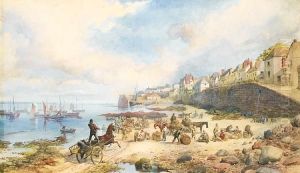Robert Michael Ballantyne Paintings
Robert Michael Ballantyne was a Scottish author of juvenile fiction who wrote more than 100 books. He was born on April 24, 1825, in Edinburgh, Scotland, into a family with a rich heritage of literature and the arts. His uncle, James Ballantyne, was a close friend and printer for Sir Walter Scott, a connection that exposed young Robert to the world of storytelling and literature from an early age. Despite this literary background, Ballantyne's early career was not in writing but in the Hudson's Bay Company, where he worked for six years in Canada. His experiences in the Canadian wilderness would later provide rich material for his novels.
Ballantyne returned to Scotland in 1847, where he began his writing career by publishing his first book, 'Hudson's Bay: or, Life in the Wilds of North America', in 1848. From this point on, Ballantyne devoted himself to writing, producing a book almost annually. His work is characterized by detailed descriptions of the natural world, adventurous plots, and a moral undertone, which reflected his Christian beliefs. Among his most famous works are 'The Coral Island' (1858), which influenced William Golding's 'Lord of the Flies', and 'The Young Fur Traders' (1856). 'The Coral Island' in particular is noted for its detailed and realistic depiction of survival on a deserted island and its exploration of themes such as civilization versus savagery.
Ballantyne's approach to writing for children was innovative for his time. He believed in writing stories that were not only entertaining but also educational, and he went to great lengths to research his subjects thoroughly, ensuring the accuracy of the information he presented. This dedication to realism and factual accuracy set a new standard for children's literature. Despite the popularity of his works during his lifetime, Ballantyne's fame waned after his death on February 8, 1894. However, his contribution to children's literature, especially in the adventure genre, remains significant, and his books continue to be read and appreciated for their historical value and storytelling prowess.

